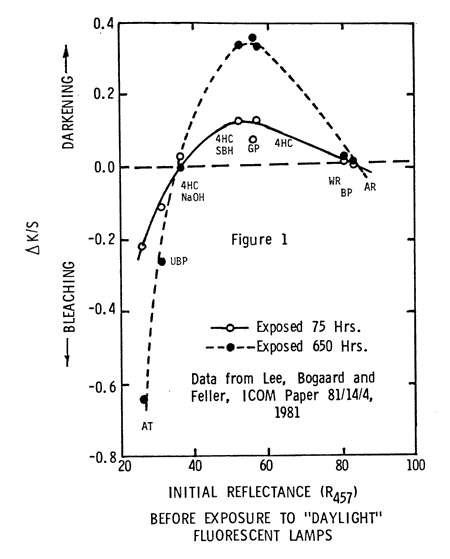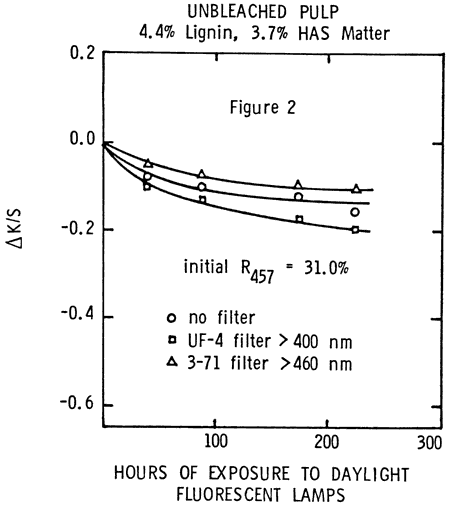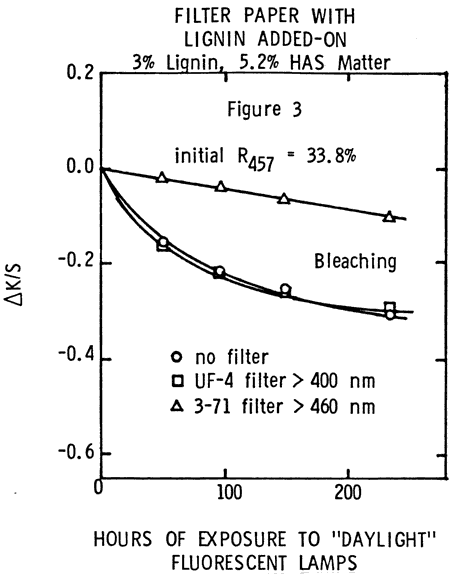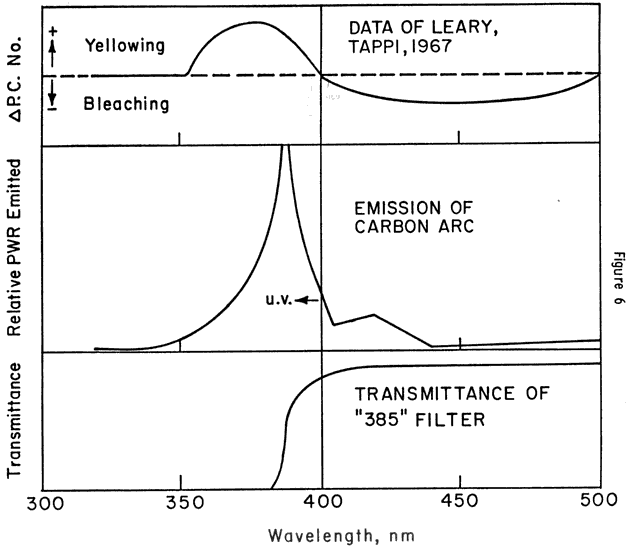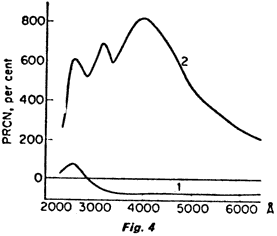The Darkening and Bleaching of Paper by Various Wavelengths in the Visible and Ultraviolet
by R. L. Feller, S. B. Lee, and J. BogaardPaper given before the Book and Paper Group at the Annual Meeting of AIC, Milwaukee, May 1982.
Introduction
These remarks will present some of the information that we are gaining from our own investigations at Mellon Institute, but mainly will review pertinent data that have been reported in the literature regarding the darkening and bleaching of various types of paper by ultraviolet and visible radiation. The subject is a challenging one because both darkening and bleaching may take place at the same time. Perhaps we can start this discussion no better than by showing some data that were derived from a previous investigation sponsored by the National Museum Act.(1)The results may not represent more than the behavior of these particular paper samples, but they will certainly stimulate discussion. In Figure 1, we have plotted the tendency to darken or bleach as a function of the initial Tappi brightness of various pulps (the reflectance at 457 nm). The very dark, largely lignin-containing, papers tended to bleach under "daylight" fluorescent lamps, whereas the handsheets of intermediate brightness tended to darken, particularly when they contained extensive oxidized material as measured by hot-l%-alkali-soluble (HAS) matter.(1) In the review that follows, we'll try to organize some of the facts concerning just when one may expect darkening; when bleaching.
As we said a number of years ago, one of the first things that one should ask in any bleaching problem is: What is it—what is the chemical substance—that you are trying to bleach? 2) Is it lignin? Lignin discoloration products? Rosin? Other? Is it the degradation products of cellulose and hemicellulose? Are the colored products the result of heat- or light-induced changes? Until we know a lot more about this subject, we suggest that one always specify whether one's conservation problem, or the research report being studied, involves papers high in lignin or practically free of lignin, and whether the discoloration had been caused primarily by ultraviolet radiation or by heat.
One should also carefully consider the type of radiation being used to carry out the bleaching. Is it a narrow range of wavelengths? A broad set of wavelengths perhaps including ultraviolet as well as visible? Middle or near ultraviolet? These are questions that one should particularly ask when reading the literature. Some effort should be made also to determine whether the temperature was or will be much above 30°C and whether the humidity is high or low.
Importance of Wavelength in Papers High in Lignin
Let us begin by showing the results of some rather simple bleaching tests of our own involving various wavelengths of radiation and various types of paper Figures 2 and 3 confirm the statement that we emphasized earlier (1): under mild conditions lignin tends to bleach. Note in Figures 2 and 3 that considerable bleaching takes place under visible radiation alone (under the OF-4 filter). Even under a filter that transmits only visible radiation above 460 nm, bleaching takes place. This is just as predicted by Nolan, Van den Akker and Wink in 1945(3), later confirmed by Leary.(4.5) It is the ultraviolet that may cause darkening, as we see in Figure 4, where the unfiltered "daylight" fluorescent lamps cause some darkening in groundwood pulp. We believe that this may be due to the fact that this particular groundwood pulp sample had a high concentration of alkali-sensitive groups, as evidenced by the high hot-l%-alkali (HAS) matter, (1) rather than having a high percentage of lignin. The fact that there is little change observed when the sheets made from this pulp was irradiated by visible radiation alone may be due to the fact that both the darkening and bleaching effects were balancing out. The fact that both processes tend to go on at the same time and that short-wavelength ultraviolet light tends to cause darkening of pulps that contain lignin is demonstrated in Figure 5; here, the same unbleached pulp shown in Figure 2 tended to darken at first; later, bleaching took over. This curve seems rather good evidence that the two processes of darkening and bleaching are going on at the same time. This same pulp, when bleached with chlorine dioxide or calcium hypochlorite, tended also to darken first, then bleach, when exposed to "daylight" fluorescent lamps.
These simple experiments indicate how important it is to consider the influence of wavelengths of radiation involved. Perhaps no better presentation of the basic facts can be cited than the work of Leary(4),shown in Figure 6 and in Tables 1 and 2. Leary used a mono-chromator to irradiate newsprint with narrow-band-widths of radiation (10 to 20 nm). As Figure 6, a qualitative representation of the information in Tables 1 and 2, indicates, darkening of newsprint, a pulp that undoubtedly contains considerable lignin, takes place principally under radiation between 360 and 390 nm in the near ultraviolet (defined as 320-400 nm) and bleaching occurs at wavelengths perhaps between 420 and 510 nm in the visible. We see in Figure 6 how confusing the results might be if one wished to irradiate such a paper with a source that contained both near ultraviolet and visible, such as the radiation from a carbon-arc fadeometer. One would have every reason to expect that both darkening and bleaching were going on at the same time under such a source or under a litter that transmitted radiation above 385 nm, as Nolan, et. al. used.(3) With such a filter, bleaching first occurred, then darkening in their experiments, leading them to conclude that there were at least two reactions going on.
The darkening of pulps that contain lignin was very well investigated in 1945 by Nolan and his co-workers.(3) We see their results in Figure 7 where the absorption curve of various lignin-containing liquors is compared to the sensitivity of lignin to discoloration (called "fading" by these authors, but really referring to darkening). Figure 7 clearly indicates what we mean when we say that lignin tends to darken as increasingly lower wavelengths of ultraviolet are employed.
Figures 6 and 7 scarcely begin to tell the story; we see in Figure 8, taken from the work of Lin and Kringstad (6) ,that irradiation by the near ultraviolet caused the extinction coefficient to decrease in the ultraviolet region; in a sense, the lignin is fading in the ultraviolet. If one looks carefully at the curves in the region of 400 nm, however, one notices that the tail of the absorption curve after exposure is actually slightly higher as it enters the visible region. Apparently we have fading in the ultraviolet and increased absorption (darkening) in the visible.
Indeed, the change in the spectral absorption and reflectance curves is complex. If one simply measures the spectral reflectance curves in the visible region as, for example, in the case of wood pulps being extracted, in the work of Polcin and co-workers seen in Figure 9(7), we find that subtle changes in the reflectance curves can hardly be interpreted. If the two sets of curves are subtracted, however, as is done in their Fig. 7, we display the spectral absorption curve of the extracted material. Subtraction of curves has frequently proven useful in discoloration work, for by means of subtraction the nature of the colored substances that were developed or removed can be detected.
In Figures 10 and 11, taken from the work of Claesson, et. al.(8) , we see in detail the results of discoloration caused by 365 nm ultra violet and bleaching brought about by the visible wavelength of 436 nm. These data represent the differences in percent reflectance after irradiation. In these curves, we see bleaching in the ultraviolet and darkening in the visible, with a peak of absorption around 430 nm. The shape of these absorption curves, in a sense, describes the colored matter that was formed upon irradiation by the ultraviolet. We also see the changes brought about during bleaching by 436 nm light.
Figures 10 and 11 (the authors' Figures 14 and 15) clearly demonstrate that one cannot learn very much about thee discoloration and bleaching of pulps by consideration of the visible region alone (such as shown in Figure 9). It is in the ultraviolet that the absorption peaks, which depend upon the particular substances involved, occur.(9)
Changes in Pure Cellulose
Thus far we have been considering the changes in the spectra of pulps high in lignin.(9) The work of Silvy and LeNest(10), on the other hand, specifically concerned the darkening of pure cellulose. Referring to Figure 12, we see, in Silvy and LeNest's Figure 2, the effects of increased heating of cellulose and note the development of absorption peaks at 260, 310 and 420 nm. (PNCR% is essentially the relative post-color number, AK/S/ K/S.) Curves 1, 2 and 3 in this figure are the results of heating the cellulose at 120°C in the dark for 13 hours, 148 hours and 3 months. Curves 4, 5 and 6 show the effects of exposure to simulated "daylight" in a Xenotest apparatus for 40 minutes, 6 hours and 70 hours, respectively. We know from our own work that thermally discolored cellulose tends to bleach, as stated earlier.(1) The authors point out that the peak absorption at 420 nm disappears most readily, the peak at 310 nm less readily and that at 260 nm is scarcely reduced at all by the light. This is a particularly illuminating illustration of the complexity of the darkening and bleaching phenomenon and shows clearly the importance of considering the absorption spectra in the ultraviolet in order to learn what is going on.
As mentioned, the work of Silvy and LeNest concerns the effects on thermally-darkened cellulose, not involving lignin. Their Figure 4, curve number 2 (in our Figure 12), shows the result of heating cellulose that had been oxidized by sodium periodate. Such material is known to have a high concentration of aldehyde, and perhaps some ketonic and acidic, groups; the authors wished to show that the absorption peaks, when this chemically oxidized material is discolored by heat (curve 2 in their Figure 4), are much the same as those found in aged papers. Curve number 1 in their Figure 4 is based on the difference in reflectance just after the cellulose had been oxidized by the periodate; the peak at 260 nm, they point out, is likely to be due to carbonyl groups for it is present in this chemically-oxidized cellulose even before thermal aging.
Rate Of Change; Post-Irradiation Effect
Having stressed that the most significant changes in the absorption spectra of pulps must be observed in the ultraviolet region, what else can we say on the basis of what has been published in the literature concerning the bleaching of darkened pulps by visible radiation? We can point out, from the work of Claesson, et. al. (8), that the darkening caused by near ultraviolet takes place very rapidly at first and then tends to slow down, perhaps reaching a constant value (Figure 13; the authors' Figure 4). The same is true for bleaching; very rapid at first and then becoming negligible as the exposure is increased (Figure 14).
We also note that there is likely to be post-irradiation darkening. This is illustrated in Figures 10 through 14. It is a phenomenon that was also pointed out by Silvy and LeNest..(10) Their Fig. 3 (our Figure 12), curve 1, shows the absorption curve after heating pure cellulose; curve 2 is the result after bleaching in "daylight" for 70 hours; and curve 3 is the intense absorption after reheating that paper in the absence of light for 25 days. Claesson's results reported in Figures 10, 11, 13 and 14 are particularly convincing. At the present stage of our knowledge regarding the bleaching of papers by visible radiation, we believe that the possibility of a post-irradiation effect—that is, thermally-induced darkening that can occur after the papers have been exposed to light—is the aspect of this procedure that must be investigated most carefully in the immediate future.
Summary
What can be said at the end of this brief review of the subject? In general, when moderate temperatures are involved, lignin tends to be darkened by ultraviolet radiation of decreasing wavelength, as shown by the work of Nolan, Van den Akker and Wink in 1945; discolored papers tend to be bleached by visible radiation, perhaps very much as Leary demonstrated for newsprint in 1967 and 1968. If radiation that contains both ultraviolet and visible is involved, both bleaching and darkening processes probably go on at the same time. If either effect predominates, the change appears to be rapid at first, and frequently tends towards a limit in the net change at any given temperature and humidity. The most significant changes in absorption tend to take place in the ultraviolet region; investigation of bleaching or darkening effects by measurement of changes in color and Tappi brightness alone are not likely to lead to major enlightenment. Until much more is learned about the processes, it is recommended that the wavelengths of radiation being employed be specified, the temperature and humidity of the samples noted and consideration given as to whether one is attempting to bleach primarily thermally or photochemically discolored lignin, degradation products of cellulose and hemicellulose, or both. An important aspect of photochemical bleaching of paper for future study is a post-irradiation effect, darkening of the sheets that may largely be thermally induced.
The authors gratefully acknowledge that this work was supported in part by a grant from the National Museum Act in FY 1981.
References
1. Lee, S. B., Bogaard, J. and Feller, R. L., "Concerning the Exposure of Paper to Light: Discoloration of Handsheets of Known Initial Lignin and Hot-Alkali-Soluble Content", Paper 81/14/4, 6th Triennial Meeting, ICOM Committee for Conservation, Ottawa (September 1981).
2. Feller, R. L., "Notes on the Chemistry of Bleaching", Bulletin of the American Group - IIC, 11, No. 2, 39-56 (1971).
3. Nolan, P., Van den Akker, J. A. and Wink, W. A., "The Fading of Groundwood by Light. II. The Physical Mechanism of Fading", Paper Trade Journal, 121, No. 11, Tappi Section 101-105 (1945).
4. Leary, G. L., "The Yellowing of Wood by Light", Tappi, 50, 17-19 (1967).
5. Leary, G. L., "The Yellowing of Wood by Light: Part II", Tappi, 51, 257-260 (1968).
6. Lin, S. Y. and Kringstad, K. P., "Photosensitive Groups in Lignin and Lignin Model Compounds", Tappi, 53, 658-663 (1970).
7. Polcin, J., Wayman, M., Anderson, C. B. and Rapson, W. H., "Sapwood and Heartwood Groundwood of Western Hemlock and Jack Pine. Part 1. Influence of Extractives on Optical Properties", Pulp and Paper Magazine of Canada, 69, No. 21, T410-T417 (1969).
8. Claesson, S., Olson, E. and Wennerblom, A., "The Yellowing and Bleaching by Light of Lignin-rich Papers and the Re-yellowing in Darkness", Svensk Papperstidning, 71, No. 8, 335-340 (1968).
9. Pew, J. C. and Connors, W. J., "Color of Coniferous Lignin", Tappi, 54, No. 2, 245-251 (1971).
10. Silvy, J. and LeNest, J. F., "Mise en dvidence par diffusion de la lumidre d'un effet photochrome de la cellulose", Comptes Rendus Des Seances De L'Academie Des Sciences, Paris, Series C, Sciences Chimiques, 271, 221-224 (1970); see also "A Photochromic Effect Shown During the Ageing of a Cellulose Material by Heat and Light", Transactions of the Symposium held at Cambridge, September 1973, ed. F. Bolam. Technical Division, The British Paper and Board Industry Federation, Plough Place, Fetter Lane, London EC4A 1AL (1976).
Tables
| Wavelength of Irradiation, nm | Observed Effect |
| 330 | Nil |
| 342 | Nil |
| 355 | Nil |
| 360 | Very slight yellowing |
| 365 | Slight yellowing |
| 370 | Yellowing |
| 375 | Yellowing |
| 380 | Yellowing |
| 385 | Yellowing |
| 390 | Very slight yellowing |
| Wavelength of Irradiation, nm | Observed Effect |
| 400 | Slight greying |
| 420 | Bleaching |
| 448 | Bleaching |
| 480 | Bleaching |
| 508 | Slight bleaching |
Figures
Figure 1.
Figure 2.
Figure 3.
Figure 4.
Figure 5.
Figure 6.

| Fig. 3. Ultraviolet absorption spectrum of spruce milled-wood lignin in methyl cellosolve before (--) and after (---) exposure to near ultraviolet light for 3 hr. |
S. B. Lee
J. Bogaard
Research Center on the Materials of the Artist and Conservator
Mellon Institute
Publication History
Received: Fall 1982
Paper delivered at the Book and Paper specialty group session, AIC 10th Annual Meeting, May 26-30. 1982, Mailwaukee, Wisconsin.
Papers for the specialty group session are selected by committee, based on abstracts and there has been no further peer review. Papers are received by the compiler in the Fall following the meeting and the author is welcome to make revisions, minor or major.
